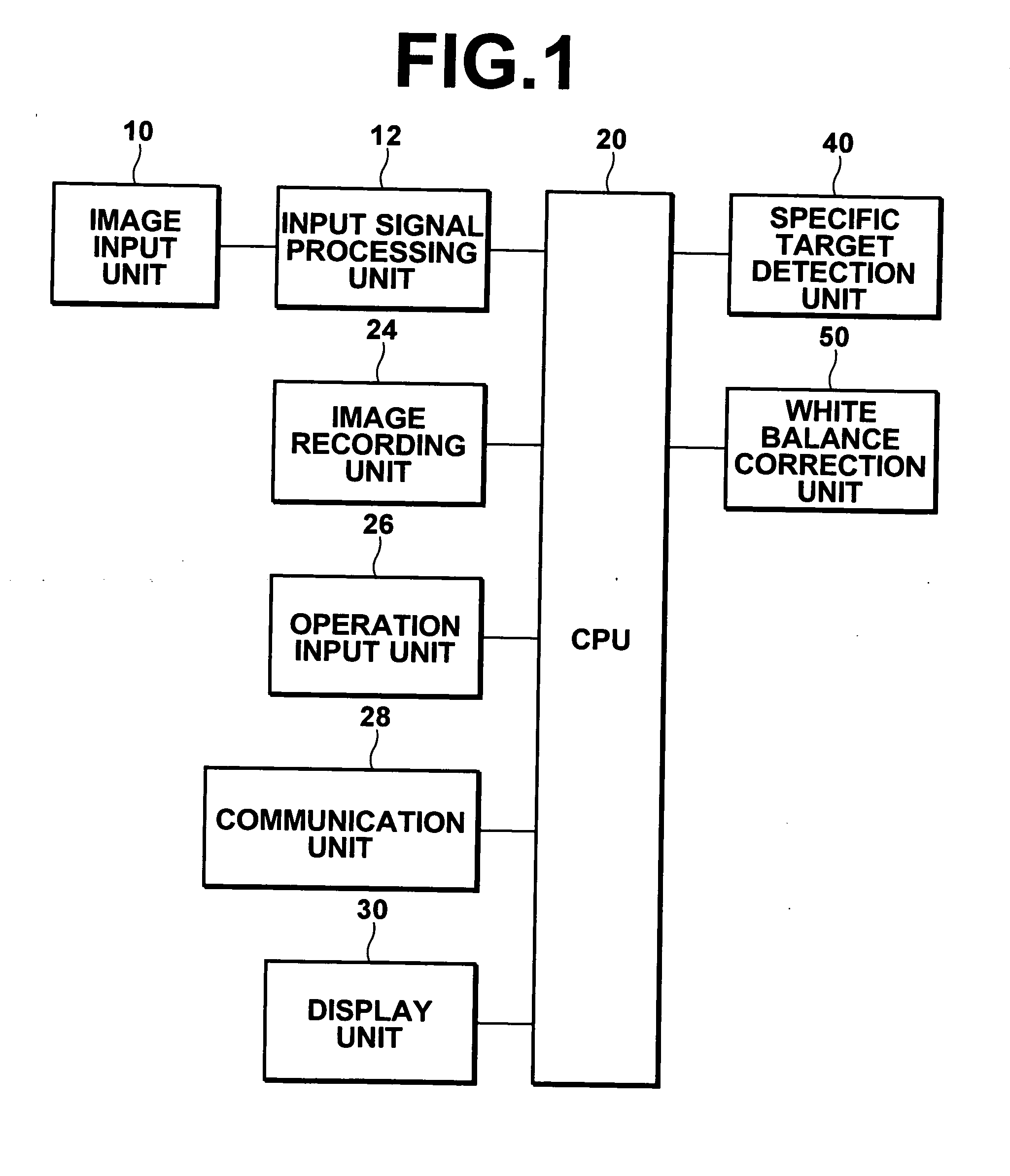White balance correction apparatus and method
a technology of white balance correction and apparatus, which is applied in the field of apparatus and methods for correcting the white balance of an image signal, can solve the problems of low sensitivity digital camera that cannot capture a weak light amount from a light source other than the main light source, and affect the color balance of the skin color portion of the face, etc., and achieves the effect of well color-balanced
- Summary
- Abstract
- Description
- Claims
- Application Information
AI Technical Summary
Benefits of technology
Problems solved by technology
Method used
Image
Examples
first embodiment
[0066]Hereinafter, a first embodiment will be described. FIG. 3 illustrates a first example subject illuminated by a plurality of light sources. The white balance correction for the picture signals obtained under such circumstances will be described as an example. The example subject is an indoor room illuminated by a ceiling light 302 of incandescent lamp. When photographing a person, which is a main subject 304, a built-in flash or an accessory flash to a photographing device 306 is sometimes used. Here, a background curtain 310 and the like are illuminated by the ceiling light 302, and the main subject 304 is illuminated by the flash 308, thus creating an area within the subject illuminated by a plurality of light sources.
[0067]FIG. 4A illustrates a photograph image of the first example subject illuminated by a plurality of light sources shown in FIG. 3, and FIG. 4B illustrates an specific target region 406 detected from FIG. 4A. FIG. 5A illustrates an example configuration of th...
second embodiment
[0083]In the first embodiment, the white balance correction unit 50 is formed by hardware. But it may be embodied by software operating on the CPU 20. This is shown in FIG. 6 and Figures following thereto, and will be described as a second embodiment.
[0084]FIG. 6 is a block diagram of an imaging apparatus 2 as an embodiment of the white balance correction means according to the present invention, illustrating the internal configuration thereof. The imaging apparatus 2 shown in FIG. 6 does not include the white balance correction unit 50 shown in FIG. 1, but the identical function is realized by the software operating on the CPU 20. The other portion is identical to that shown in FIG. 1, and it will not be elaborated upon further here.
[0085]FIG. 7 is a flowchart as an embodiment of the white balance correction value calculation means according to the present embodiment. Here, due to software processing, image signals are divided into K blocks in the x direction, and L blocks in the y...
example modification
of the Second Embodiment
[0098]In the second embodiment, the use of the first or second white balance correction value is determined with respect to each block (step S806 in FIG. 8). It is possible, however, that an intermediate region between the specific target region and the region other than the specific target region may exist. If such is the case, the use of a white balance correction value according to the intermediate region allows a more effective white balance correction. This will be described as an example modification of the second embodiment.
[0099]FIGS. 9A to 9C illustrate an example case in which a low-pass filter is applied to the block discrimination value B(X, Y). As described earlier, the block discrimination value B(X, Y) is set to “1” if the block is the first hue evaluation value calculation region, or set to “2” if the block is the second hue evaluation value calculation region. The first or second white balance correction value is applied according to the firs...
PUM
 Login to View More
Login to View More Abstract
Description
Claims
Application Information
 Login to View More
Login to View More - R&D
- Intellectual Property
- Life Sciences
- Materials
- Tech Scout
- Unparalleled Data Quality
- Higher Quality Content
- 60% Fewer Hallucinations
Browse by: Latest US Patents, China's latest patents, Technical Efficacy Thesaurus, Application Domain, Technology Topic, Popular Technical Reports.
© 2025 PatSnap. All rights reserved.Legal|Privacy policy|Modern Slavery Act Transparency Statement|Sitemap|About US| Contact US: help@patsnap.com



